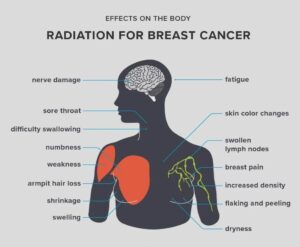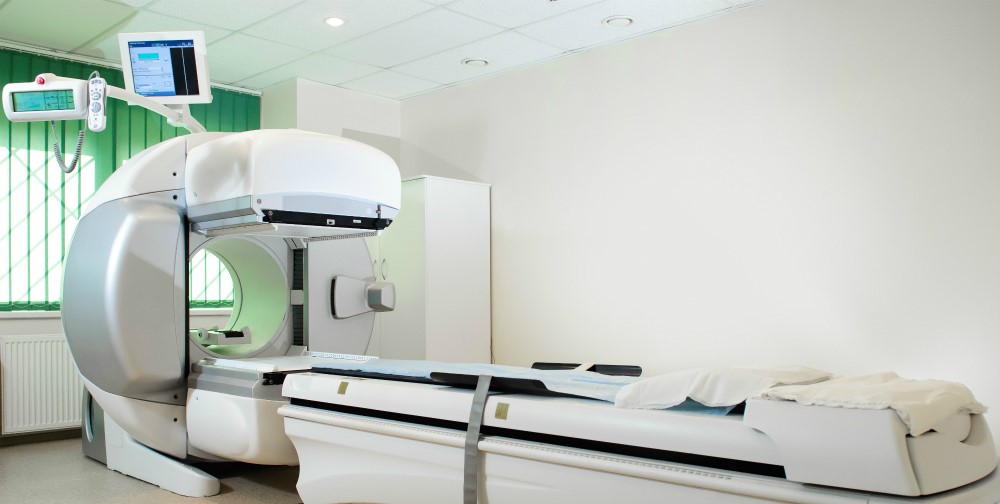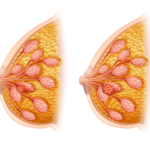Every breast cancer patient has an individualized treatment plan curated by their medical team. This may include surgery like a lumpectomy or mastectomy, hormone therapy, chemotherapy, or radiation (radiotherapy). If your doctor recommends radiation, there is a chance you will experience both short-term and long-term side effects, as with any treatment. But, compared to chemotherapy, radiotherapy is a lot easier to deal with and comes with fewer potential issues.
Radiation can be used on its own or in combination with other treatments or surgeries and can be used before or after surgery, depending on the stage of your cancer and your doctors’ recommendations. Despite its many positive attributes, it is often misunderstood by breast cancer patients. On a positive note, radiation only affects an exact, targeted area, and your doctor will select a dose that will be the most effective without damaging as much healthy tissue as possible. However, sensitivity varies from patient to patient, and there’s no way to predict which patients will have what reactions accurately. Some side effects won’t appear until months or years after your treatment.
If you have a higher dose of radiation, your chances of getting side effects are more likely — but if you get too low of a dose of radiation, it won’t be as effective against the cancer and could leave cancer cells alive.
Are Some Therapies More Effective Based on Stage?
The type of radiation treatment you get depends on the stage of breast cancer. People with early stage 3 breast cancer will benefit most from radiation treatment. Radiation can also help ease side effects in people with advanced breast cancer.
How Radiation Therapy Works Against Cancer
At high doses, radiation therapy kills cancer cells or slows their growth by damaging their DNA. Cancer cells whose DNA is damaged beyond repair stop dividing or dying. When the damaged cells die, they are broken down and removed by the body. Radiation therapy does not kill cancer cells right away. It takes days or weeks of treatment before DNA is damaged enough for cancer cells to die. Then, cancer cells keep dying for weeks or months after radiation therapy ends.
Types Of Radiation Therapy
There are two main types of radiation therapy: external beam and internal. The type of radiation therapy that you may have depends on many factors, including:
- the type of cancer
- the size of the tumor
- the tumor’s location in the body
- how close the tumor is to normal tissues that are sensitive to radiation
- your general health and medical history
- whether you will have other types of cancer treatment
- other factors, such as your age and other medical conditions
External Whole Breast Radiation Works Best:
- for early-stage to stage 3 breast cancer
- for tumors that are an inch or smaller
- if the cancer is in one spot
- if you had breast-saving surgery or a mastectomy
External beam radiation can also help treat the side effects of advanced breast cancer.
Internal Radiation Works Best:
- for early-stage breast cancer
- if the cancer is in one spot
- if you had breast-saving surgery or a mastectomy
Sometimes, a person with advanced breast cancer will have internal radiation.
Intraoperative Radiation Works Best:
- during early-stage breast cancer
- when the tumor is too close to healthy tissue for external radiation to be possible
Not everyone can have intraoperative radiation or internal beam radiation. Whether you can have these procedures depends on the following:
- size and location of the tumor
- size of your breast
- your age
- type of cancer cells
Radiotherapy after breast-conserving surgery (lumpectomy), or after breast-conserving surgery, you might have one of the following:
- radiotherapy of the whole breast
- radiotherapy to a part of the breast (partial breast radiotherapy)
Your doctor can tell you whether you need radiotherapy for the whole breast or only for a part of the breast. This depends on the risk of your cancer coming back. You may not need to have radiotherapy after surgery if your cancer has a very low chance of coming back.
- You generally start radiotherapy about 4 to 8 weeks after surgery or chemotherapy
- Radiotherapy after removal of the breast (mastectomy)
- You may have radiotherapy after a mastectomy if there is a high risk of the cancer returning
Age May Determine What Type of Radiation Therapy
The good news is that both whole-breast and partial-breast radiation therapy after a lumpectomy are effective in preventing early-stage cancers from recurring. However, partial-breast radiation therapy may not be suitable for younger women who have not gone through menopause. Breast cancer in these women tends to be more aggressive and less likely to respond to treatments. Women should talk to their doctors to make the best choice.
Medical Suggestions from Your Oncologist:
- if cancer cells are found in the lymph nodes in the armpit (axilla) or the lymph nodes behind the breastbone
- cancer cells are seen close to the removed breast tissue. This is called close or positive margins
- the cancer is large when diagnosed
- radiotherapy of the lymph nodes
The treatment is usually surgery to remove the lymph nodes or sometimes radiotherapy. Your doctor will tell you which lymph node areas need treatment.
Radiotherapy Breast Boost
You may also have a boost of radiotherapy to the breast. A boost is an extra amount (dose) of radiotherapy targeted at the area in the breast where the cancer was removed. You might have this if you have had your whole breast treated with radiotherapy after breast-conserving surgery. It helps reduce the risk for people who have a higher risk of cancer coming back.
The boost dose may be given simultaneously with your whole breast radiotherapy. Or you may have 1 to 5 extra treatments at the end of the treatment to your breast. Not everyone needs radiotherapy boosts. Your doctor will tell you if it’s suitable for you.
Radiotherapy For Secondary Breast Cancer
Radiotherapy helps treat breast cancer that has spread to different parts of the body. This is secondary or advanced breast cancer. The treatment can usually shrink the cancer and help relieve any symptoms.
Radiotherapy To Treat Breast Cancer That Has Spread to The Bones
You usually have one fraction or treatment for the areas of the bone where the breast cancer has spread. It can help strengthen the bone and relieve pain. You may overlook the benefit immediately, as the treatment can take some days.
For some people with early-stage breast cancer, new clinical trial results show that a condensed course of radiation therapy is as safe and effective as a longer course. Women with early-stage breast cancer who had surgery to remove the tumor (lumpectomy) had a relatively higher risk of cancer returning at the site of the surgery. For these women, the trial found the time needed for daily radiation therapy could safely be shortened from about 4-6 weeks to 3 weeks.
Experts stated this shorter course of treatment makes radiation therapy less burdensome for patients. For people with higher-risk early-stage breast cancer, the recommended treatment may include an extra 4-8 days of radiation to the area of the breast where the tumor was located.

Short-Term Side Effects May Include:
Short-term side effects occur during the treatment or directly afterward, usually within 6 months.
Pain: Some people experience mild discomfort, pain around the breast, or stiffness in the shoulder area. Over time, treatments should become less uncomfortable.
Skin changes: Skin damage is a common side effect of radiation therapy, and having a good skincare routine is essential during treatment. Changes to the skin can include:
- color changes
- peeling or flaking
- skin that feels tender, dry, itchy, or sore blisters
- excess moisture and weeping
Swelling: The breast or surrounding tissue may become swollen or inflamed. Swelling should reduce within a few weeks of the end of treatment.
Hair loss: in the armpit or chest: When a doctor applies radiation to the lymph nodes in the armpit and chest, it can cause hair loss.
A sore throat: Applying radiation to the lymph nodes around the collarbone can cause a sore throat or difficulty swallowing. These symptoms should improve once the treatment is complete.
Fatigue: Radiation can cause someone to feel fatigued. Being in the hospital and having other treatments, such as chemotherapy, can worsen this fatigue. It is essential to sleep and rest as much as possible during treatment.
Long-Term Side Effect
Long-term side effects occur months or years after treatment has ended. Side effects can include:
- Breast changes: The breasts may shrink or become denser after radiation, and problems breastfeeding.
- Brachial plexopathy: Radiation to the breast or chest wall can sometimes damage the nerves that run through the arm, wrist, and hand. Nerve damage can cause numbness, pain, or weakness in the area.
- Lymphedema: Lymphedema is swelling of the arm, hand, or chest. Radiation can sometimes damage nearby lymph nodes, leading to a buildup of lymph fluid.
Radiation burns (radiation dermatitis) affect more than 90% of the approximately 4 million Americans who receive radiation therapy for cancer each year. For many, radiation burns are mild and can easily be treated. However, about 20% of people who receive radiation therapy will have more severe burns whose symptoms can interfere with their daily lives.
Although anyone receiving radiation therapy can develop burns, studies show the burns are most common in those with breast cancer, head and neck cancers, or cancers that develop on or near the skin, such as skin or anal cancers.
What Happens When You Get Radiation Burns?
Radiation therapy uses X-ray beams aimed from outside your body to kill cancer cells inside the body. These beams can also damage healthy cells. Because the radiation beams must pass through your skin to reach the cancer, skin changes such as burns can occur on or around the treated areas.
Radiation burns don’t appear right away. Instead, they usually appear one to two weeks after starting treatment. Burns can develop even after your final radiation session because the therapy keeps working in the body after treatment is finished.
Appearance
Radiation burns are more likely to occur in areas of the body where skin touches the skin, such as the armpits or under the breast, or areas with a lot of sun exposure. Their appearance on the skin can include:
- Redness of white skin or darkening of black or brown skin
- Dryness
- Peeling
- Blistering
- Swelling
Weeping radiation burns, in which the skin becomes wet and sore, can also occur and usually appear in places with skinfolds, such as under the breasts or armpits.
Sensation
Radiation burns can be painful and feel like a sunburn. Burns may feel:
- Itchy
- Burning
- Sore
What Degree Are Radiation Burns?
Radiation burns are categorized by degree, like thermal burns (burns you receive from coming into contact with hot objects like a stove). First-degree burns appear as red, dry skin with moderate pain and itching. Second-degree burns occur as red, moist skin that blisters. Pain and itching can be mild to severe.
First Aid for Radiation Burns
Treating your skin with care during and after radiation therapy is essential to help you feel more comfortable and recover quickly. Follow your healthcare provider’s instructions for taking care of your skin and consult with them if you experience any skin changes or if your radiation burn symptoms are worsening. Seek emergency care if you have radiation burns and develop any of the following symptoms, which might signal an infection:
- A fever
- Skin that’s unusually red or reddens quickly.
- Liquid draining or a bad smell coming from the burn.
Treatment
If you experience radiation burns, there are at-home, over-the-counter (OTC), and prescription treatments to help, which can include:
- Gentle washing: Clean treated skin daily with warm water and a low-pH cleanser to remove bacteria. Don’t use washcloths or loofahs; splash water on the skin.
- Aloe vera: This plant is a natural anti-inflammatory. Applying fresh aloe vera juice daily to the affected skin can help lessen skin damage from radiation therapy.
- Calendula cream: Known for its antibacterial, anti-inflammatory, and antioxidant effects, studies show promising results in preventing and treating radiation burns.
- OTC hydrocortisone cream: For mild itching and burning, this cream can be applied thinly over the affected area three times a day but not within one hour of treatment.
- Prescription creams: Your healthcare provider may give you a corticosteroid or other prescription cream for your skin. Be sure to follow directions on when to apply any prescription cream.
To protect your skin from further irritation during radiation therapy
Spending time outdoors and leisure time: Being outside can help relieve stress, but you want to protect your skin from harmful ultraviolet (UV) rays, heat, and cold. This is what dermatologists recommend:
- Cover your treated skin with sun-protective clothing. The sun can irritate skin that’s been treated with radiation. Before going outdoors, put on sun-protective clothing. You can find sun-protective clothing online, but any clothing you hold up to a bright light and cannot see through offers sun protection. Just make sure that the clothing is loose-fitting. A wide-brimmed hat can protect your head and neck.
- Use the sunscreen that your care team recommends. Your care team will recommend skin care products that you can use, including sunscreen. If you don’t remember getting a recommendation for sunscreen, ask someone on your care team which sunscreen you should use.
- Seek shade when outdoors. This helps to protect your skin from the sun’s UV rays.
- Don’t use a tanning bed or other tanning device. These emit more UV rays than the sun, which can seriously damage your skin.
- Skip the hot tub. The heat can irritate your skin. You could also develop a severe infection if the hot tub isn’t properly cleaned.
- Bundle up when the temperature nears (or falls below) freezing. The cold can irritate your skin. To prevent this, bundle up when it’s cold outdoors and limit your time outside.
- Avoid putting anything too hot or cold, such as a heating pad or ice pack, or sticky, like a bandage, on your treated skin.
- Skip the antiperspirant and talcum powder. Ingredients in these products can increase the amount of radiation you get. You can use deodorant instead of antiperspirant. However, discontinue usage if redness, swelling, or soreness develops when you apply the deodorant.
Do The Burns Go Away or Get Worse Over Time?
Radiation burns typically get better within a few weeks of radiation therapy ending. If your burns are causing more than mild to moderate symptoms, you must talk to your healthcare provider. Sometimes, your radiation schedule or dosage can be changed to give burns more time to heal.

Skincare During Radiation Therapy
Radiation therapy plays a vital role in treating cancer. However, it can also produce uncomfortable or painful side effects on the skin, such as itchiness, redness, blistering, and peeling.
To take care of your skin during radiation therapy, follow these tips from board-certified dermatologists.
Radiation therapy plays an essential role in treating cancer. Like medications, radiation therapy can also cause possible side effects. Some of these side effects occur on the skin, but the proper skin care during radiation therapy can:
Reduce Side Effects on Your Skin
- Help your skin feel more comfortable during treatment; this will allow your skin to recover more quickly after treatment.
Here’s how dermatologists recommend that you care for your skin before and after radiation therapy. During radiation therapy: Be gentle and protect your skin. You want to start doing the following on the day you begin radiation therapy and continue until you’ve stopped radiation and your skin feels normal.
Bathing and shaving: Skin can become very sensitive during radiation therapy.
You can reduce the risk of side effects by following these tips:
- Wash the treated skin gently every day with warm water. Washing helps remove bacteria from your skin, which can cause an infection. Be very gentle when washing your skin in the area where you are receiving radiation therapy. You can easily irritate it, which can cause side effects on your skin. To avoid irritating your skin, skip the washcloths, sponges, and loofahs. Instead, use your hands to splash water on the treated skin gently.
- Use a gentle, low-pH cleanser if you need to cleanse. Your care team may recommend skin care products that you can use. If not, ask. When using a cleanser, gently apply it with your hands and rinse it with warm water. Again, you don’t want to use a washcloth or sponge, which can irritate your skin.
- Ignore the lines drawn on your skin. You may want to scrub these lines off, but trying to remove them will irritate your skin.
- Avoid shaving the treated skin. This can irritate your skin, which could cause a painful rash.
- Apply moisturizer every day as directed. This helps your skin recover quickly from treatment but doesn’t apply moisturizer to a wound. Use only the moisturizer your cancer team recommends and apply it as directed.
Getting dressed: Making the following changes until your skin feels normal can help reduce possible side effects:
Care for wounds as directed. Some people develop redness, sores, or scabs during radiation therapy. If you need to care for a wound, be sure to follow the directions you’re given. Doing so can help your skin recover quickly and avoid a severe reaction.
Take a break from products that contain fragrance. Makeup and skin care products often contain fragrance, which can irritate your skin and cause a reaction. Unless a product says it’s “fragrance-free,” it’s likely to contain fragrance. Even unscented products contain fragrance.
Wear loose-fitting clothes: You can develop side effects if clothing rubs against skin treated with radiation. Wearing loose-fitting clothing helps to prevent these side effects.
Spending time at home: Until therapy is over and your skin feels normal, dermatologists recommend the following:
Protect your treated skin while doing chores. If you’re getting radiation treatments on your hands or lower arms, you’ll want to protect your skin with gloves while doing chores like dishes.
After radiation therapy: Pay attention to your treated skin.
Some side effects occur weeks, months, or years after your last radiation treatment. This can happen even if you have no side effects during treatment. To catch these side effects early, dermatologists recommend the following:
- Watch your treated skin for signs of change. After treatment, paying close attention to the skin treated with radiation therapy is essential.
- Call your oncologist or dermatologist if you see redness, a rash, or any other change.
Rash Caused by Radiation-Therapy
Proper skin care may lessen the side effects on your skin.
Protect the treated area from the sun. Anyone who has had radiation treatments has a higher risk of developing skin cancer in that area. Skin cancer tends to appear many years later, making sun protection essential for life. Make an appointment to see a board-certified dermatologist. By having a dermatologist, you have a specialist to see if you develop a skin problem later. This is especially important since you have a higher risk of developing skin cancer.
Dermatologists treat skin problems caused by cancer treatment.
As skin, hair, and nail specialist, dermatologists are often called upon to treat reactions caused by cancer treatment. They are familiar with the many reactions that can occur during and years after cancer therapy. If you develop a skin problem after cancer treatment, you do not have to live with the discomfort.
Radiation burns and other side effects of radiation therapy can also cause mental and emotional side effects. Seek help if you are experiencing anxiety or stress. Talk to your healthcare team about exercising, eating right, and getting enough rest—these things can help support your mental health during treatment.
Lifetime Dose Limits
There is a limit to how much radiation an area of your body can safely receive throughout your lifetime. Depending on how much radiation an area has already been treated with, you may not be able to have radiation therapy in that area a second time. But, if one area of the body has already received the safe lifetime radiation dose, another area might still be treated if the distance between the two areas is large enough.
SUMMARY
Radiation burns are a common side effect of radiation therapy and can cause symptoms such as pain, itching, and soreness ranging from mild to severe. The burns typically appear one to two weeks after starting radiation treatment and can continue for weeks after completing it. Try at-home care and OTC or prescription creams to help prevent burns and decrease their severity.
REFERENCES
AAD – American Academy of Dermatology Association
Cancer Research UK
Harvard Health
Healthline
Medical News Today
Memorial Sloan Kettering Cancer Center
National Breast Institute
National Cancer Institute
The Breast Cancer Site News
VerywellHealth









